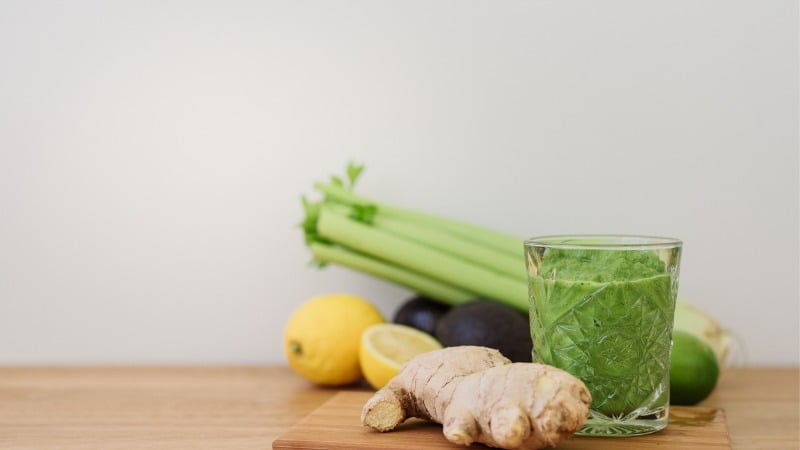By Nancy Maffia
Inflammation is the root cause of many chronic health issues, from joint pain to digestive disorders and heart disease. If you’re experiencing stiff joints, bloating, or chronic fatigue, making simple changes to your diet can dramatically improve your overall well-being.
This list covers 22 of the best anti-inflammation foods so you can start following a low-inflammation diet that supports your long-term health.
Plus, if you’re a picky eater, you’ll find anti-inflammation recipes that make eating healthy easier.
1. Fatty Fish (Salmon, Mackerel, Sardines)
Omega-3-rich fish are some of the best low-inflammation foods, reducing inflammatory markers and improving joint mobility.
Fatty fish can help heal inflammation by lowering C-reactive protein (CRP) levels, a marker linked to chronic inflammation.
If seafood isn’t your favorite, try adding fish oil supplements or incorporating anti-inflammation recipes like salmon patties or grilled mackerel with lemon and herbs.
2. Leafy Greens (Spinach, Kale, Swiss Chard)
Dark leafy greens—like spinach, kale, and Swiss chard—are inflammation-fighting powerhouses. Packed with vitamins, minerals, and antioxidants, they help combat oxidative stress and reduce inflammation in joints.
Adding more greens to your diet is simple. Toss them into salads, smoothies, or stir-fries for a delicious way to enhance your low-inflammation diet.
3. Berries (Blueberries, Strawberries, Raspberries)
Berries are loaded with anti-inflammatory compounds like polyphenols and anthocyanins, which help reduce joint swelling and chronic pain . They also provide a natural way to heal inflammation while satisfying your sweet tooth.
Eat them fresh, blend them into smoothies, or use them in inflammation diet recipes like oatmeal bowls or yogurt parfaits.
4. Turmeric (with Black Pepper for Better Absorption)
Turmeric’s active compound, curcumin, is one of the most powerful anti-inflammatory foods. It works by blocking inflammatory pathways and improving overall joint health.
To maximize absorption, always pair turmeric with black pepper. Add it to soups, teas, or golden milk lattes for a simple anti-inflammation diet recipe,
5. Ginger (Fresh or Powdered)
Ginger is a natural remedy for foods that cause inflammation in joints, as it contains gingerols that reduce swelling. It’s especially useful for those suffering from arthritis or digestive inflammation.
Try drinking ginger tea, adding fresh ginger to stir-fries, or making an inflammation-fighting smoothie.
6. Avocados
Loaded with healthy monounsaturated fats, fiber, and magnesium, avocados support a low-inflammation diet by reducing oxidative stress and supporting heart health.
Use them in guacamole, salads, or even smoothies to boost your intake of anti-inflammation foods.
7. Nuts & Seeds (Almonds, Walnuts, Chia, Flaxseeds)
These are packed with omega-3 fatty acids, fiber, and antioxidants that help heal inflammation and reduce joint pain.
Snack on a handful of almonds, sprinkle flaxseeds in your oatmeal or blend walnuts into inflammation diet recipes for a crunchy, nutritious boost.
8. Green Tea
Green tea contains EGCG, a compound that actively fights inflammation while improving brain and heart health. It also helps counteract foods that cause inflammation in joints by reducing oxidative stress.
Replace coffee or sugary drinks with a daily cup of green tea to support your low-inflammation diet.
9. Dark Chocolate (At Least 70% Cocoa)
Dark chocolate is rich in flavonoids, which can reduce inflammatory responses and improve circulation. But be cautious—some chocolates contain added sugars, which belong on the inflammatory foods list.
Choose at least 70% dark chocolate to enjoy its anti-inflammation benefits without excess sugar.
10. Tomatoes (Cooked for More Lycopene)
Tomatoes are packed with lycopene, a powerful antioxidant that lowers inflammation. Cooking them enhances their benefits, making tomato sauce, soups, and roasted tomatoes excellent choices.
Pairing tomatoes with olive oil improves absorption, making it a great addition to inflammation diet recipes.
11. Extra Virgin Olive Oil
A key component of the low-inflammation diet, olive oil contains oleocanthal, a compound with effects similar to ibuprofen. It helps heal inflammation naturally and supports heart health.
Use it as your primary cooking oil or drizzle it over salads and roasted veggies.
12. Mushrooms (Shiitake, Maitake, Reishi)
Mushrooms contain unique polysaccharides that lower inflammatory responses and boost immune function.
Adding mushrooms to soups, stir-fries, or salads makes them a delicious part of an anti-inflammation foods plan.
13. Sweet Potatoes
Rich in beta-carotene and fiber, sweet potatoes help regulate blood sugar and reduce inflammation.
Swap regular potatoes for sweet potatoes in your meals to reduce inflammatory stress.
14. Pomegranates
Pomegranates are loaded with punicalagins, compounds that actively fight inflammation and protect joint health.
Drink pure pomegranate juice or eat the seeds for an easy way to support a low-inflammation diet.
15. Lentils
Lentils are fiber-rich, plant-based protein sources that stabilize blood sugar and promote gut health—both essential for healing inflammation.
Use them in soups, stews, or salads for a nutrient-packed, anti-inflammatory meal.
16. Beets
Beets are vibrant root vegetables packed with betalains, powerful compounds known for their anti-inflammatory and detoxifying properties. These compounds help reduce oxidative stress and support the body’s natural ability to heal inflammation.
Adding beets to your diet can improve blood circulation and liver function, both essential for a low-inflammation diet.
Enjoy them roasted, blended into smoothies, or added to salads for a delicious and nutrient-packed boost.
17. Bell Peppers
Bell peppers, especially red and yellow varieties, are loaded with vitamin C and quercetin, which help reduce oxidative stress and inflammation. They also contain carotenoids, antioxidants that help protect against chronic diseases linked to inflammation.
Unlike spicy peppers, bell peppers are mild and sweet, making them great for picky eaters who want to follow an inflammation diet recipe without too much heat.
Add them to stir-fries, salads, or snack on them raw with hummus for a healthy, crunchy treat.
18. Pineapple
Pineapple is a tropical fruit packed with bromelain, an enzyme known for its ability to reduce swelling and promote digestion. This enzyme helps break down proteins and reduce inflammation in joints, making it an excellent addition to an anti-inflammation foods plan.
Blend pineapple into smoothies, eat it fresh, or add it to stir-fries for a delicious way to heal inflammation naturally.
Just be mindful of added sugars in canned or processed pineapple.
19. Carrots
Carrots are rich in beta-carotene, fiber, and antioxidants, which help combat free radicals and reduce inflammation in the body. They are especially beneficial for eye health, immune function, and skin repair.
Roast carrots, blend them into soups, or enjoy them raw as a snack for a crunchy, nutrient-dense way to support your low-inflammation diet.
20. Oranges
Oranges are a powerhouse of vitamin C and flavonoids, essential for reducing oxidative stress and strengthening the immune system.
Their natural acidity and fiber also support gut health, which plays a significant role in controlling inflammation.
Drinking fresh orange juice (without added sugar) or eating whole oranges with the peel’s inner white fiber (pith) can provide maximum anti-inflammatory benefits.
21. Broccoli
Broccoli is a cruciferous vegetable rich in sulforaphane, a powerful compound known for its ability to lower inflammation and protect against chronic diseases. It helps detoxify harmful substances from the body while supporting heart and joint health.
Steam, roast, or stir-fry broccoli with olive oil and garlic to maximize its nutrient absorption.
It’s a great option for picky eaters who might not enjoy the bitterness of other leafy greens.
22. Garlic
Garlic is a natural anti-inflammatory and immune booster, thanks to its sulfur compounds like allicin. These compounds help reduce inflammatory markers in the body while improving heart health and fighting infections.
For best results, crush or chop fresh garlic and let it sit for a few minutes before cooking to activate its healing properties.
Add it to soups, stir-fries, and sauces for an easy way to enhance your anti-inflammation diet recipes.
—
This post was previously published on NATUREOFHOME.COM and is republished on Medium.
—
Photo credit: iStock
Publisher: Source link




